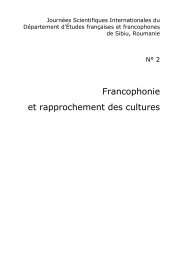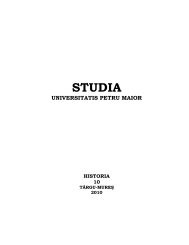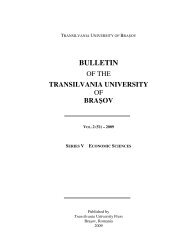„ovidius†constanţa - Biblioteca Universitatii "LUCIAN BLAGA" SIBIU
„ovidius†constanţa - Biblioteca Universitatii "LUCIAN BLAGA" SIBIU
„ovidius†constanţa - Biblioteca Universitatii "LUCIAN BLAGA" SIBIU
You also want an ePaper? Increase the reach of your titles
YUMPU automatically turns print PDFs into web optimized ePapers that Google loves.
Analele Universităţii „OVIDIUS” – Seria Istorie<br />
Volumul 4, 2007<br />
TĂTARII ŞI SEPARATISMUL CRIMEEAN<br />
The Tartars and Crimean separatism<br />
Omer METIN �<br />
Abstract: The declaration of independence of Ukraine on 24 of August 1991 was the very<br />
moment that marked the region of Crimea with a series of issues in respect of the<br />
authorities of Kiev. The complexity of the situation in point of the above mentioned<br />
region might be said to have been the result of the contribution of several factors. The<br />
presence of a Russian majority in the peninsula favorized the appearance of a movement<br />
that had as distinct aims the realization of an overall autonomy and even the separation<br />
from Ukraine. The strategic importance determined the involvement of Russia that, by<br />
means of policy of the naval base from Sevastopol, supported the Russian separatist<br />
movement. The affiliation of Crimea called forth serious debates. Untill 1954 the<br />
mentioned region was part of the URSS and the date of 19th of February marked its<br />
assignment to R.S.S. Ukraine. The return of Crimean Tartars which was one of the<br />
deported nations by the order of Stalin contributed significally to the tenseness of the<br />
situation. The issue of Crimean separatism appeared after the division of URSS and<br />
influenced Ukraine the political, economical and social areas. The geostrategic<br />
influence of the Crimean position determined the involvement of Turkey that ulterior<br />
became the ally of Ukraine. If for Ukraine the interest as regars the situation of Tartars<br />
is only part of the policy of peace maintenance of the peninsula within its own borders,<br />
for Turkey the lobby of diaspora and the involvement of certain Tartar personalities in<br />
the political, cultural and economic domanis has greatly contributed in respect of<br />
external decisions of Turkey.<br />
Keywords: Crimean separatism, political crisis, new order, protest act.<br />
De la declararea independenţei Ucrainei la 24 august 1991, Crimeea a<br />
fost regiunea care a creat cele mai mari probleme autorităţilor de la Kiev.<br />
Complexitatea situaţiei din această zonă a fost determinată de mai mulţi factori.<br />
Prezenţa unei majorităţi ruse în peninsulă a favorizat apariţia unei mişcări care<br />
dorea o mai mare autonomie sau chiar separarea de Ucraina. 1 Importanţa<br />
strategică a determinat implicarea Rusiei care în politica de păstrarea a bazei<br />
navale de la Sevastopol a sprijinit mişcarea separatistă rusă. Apartenenţa<br />
Crimeei a stârnit alte dezbateri. Până în 1954 aceasta a fost parte a URSS, la 19<br />
februarie fiind transferată în administraţia R.S.S. Ucraina. 2 Reîntoarcerea tătarilor<br />
� Student, Facultatea de Istorie şi Ştiinţe Politice, Constanţa.<br />
1 Conform recensământului din 2001 dintr-un total de 2033700 de locuitori, compoziţia<br />
etnică era următoarea: 58,5% ruşi, 24,4% ucraineni, 12,1% tătari crimeeni, restul<br />
naţionalităţilor având sub 2% fiecare. http://www.ukrcensus.gov.ua/eng/regions/reg_crym/<br />
2 De la 18 octombrie 1921 până la 30 iunie 1945, Crimeea, a avut statutul de Republică<br />
Autonomă Sovietică Socialistă în cadrul Republicii Sovietice Federative Socialiste Ruse. În<br />
ISSN -1841-138X 115 © 2007 Ovidius University Press









